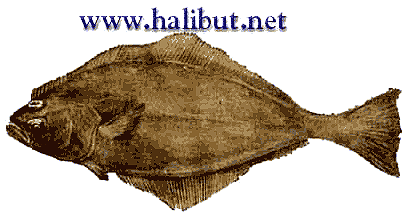|
Handling
Halibut
A halibutís mass of muscle can
injure or kill the unprepared. I recall a buddyís first
introduction to a halibut: he dropped a 40-pounder on the deck
straight from the sea without killing or subduing it first. As he bent
down to try and control the angry mass, the halibutís tail slapped
his chest and face until he hosted two black eyes and a cracked rib!
Subduing a halibut, safety and proper care
for the dinner table go hand in hand. Do it right and youíll have
top-quality fillets to eat. Do it wrong and you may need help feeding
yourself!
While many halibut hunters argue the virtues
of a gun when subduing halibut over 50-pounds, many others opt for a
safer harpoon or flying gaff. If you choose to shoot a halibut in the
head, you might destroy its cheeks, the best eating part of the beast.
And donít forget, Canada frowns of the use of guns, especially
pistols.
Netting halibut under 50-pounds remains a
practice, but only by those whoíve never landed one before. Gaff or
harpoon the little guys, youíll save yourself the cost of a net in
most cases.
Trumble offers this advise, "You want to
keep the halibutís head under water. As soon as you bring the head
out of the water, they go crazy. I donít bring any big fish on
board, until itís dead."
When harpooning a halibut, aim for a solid
area, behind the head and ram all the way through with the harpoon. A
line attached to a "Scottsman" buoy can be thrown overboard
if necessary, just like having a trout on a bobber and worm. Wait for
the fish to tire and bleed, bring it alongside the boat, hog tie it
and cut the gill rakers. Bleeding the fish helps to kill the beast
along with providing bloodless meat. Once the halibut is dead, put
Ďem on ice if you can.
Filleting halibut yields a better product
than steaking. If you plan on freezing the fillets longer than two
months, leave the skin on and rinse the fish with saltwater before
vacuum packing. This method ensures top-quality meat for many months.
We hope you enjoyed
visiting

|
Copyright
John
L. Beath 2000 halibut.net a division
of Pacific Lure Communications |
|